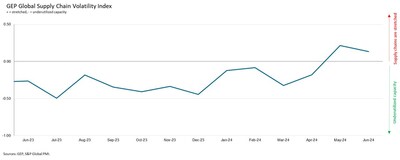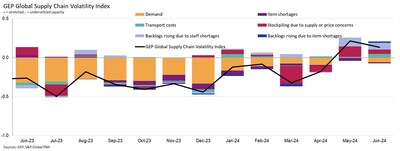ASIA'S SUPPLIERS GROWING AT THE FASTEST PACE SINCE EARLY 2023, AS GLOBAL MANUFACTURING GATHERS FURTHER MOMENTUM IN JUNE: GEP GLOBAL SUPPLY CHAIN VOLATILITY INDEX
The GEP Global Supply Chain Volatility Index remained in positive territory for the second consecutive month in June 2024, highlighting increased global supply chain activity. The index stood at 0.13, slightly down from May's 0.21. Asian manufacturing, particularly in China, Taiwan, Vietnam, and India, saw significant growth, driving up input demand. Conversely, North American suppliers experienced a slight decline in demand, indicating a tightening economy. European manufacturing activity remains subdued but has improved compared to late 2023. Global transportation costs reached a 20-month high, reflecting increased shipping and container rates. Labor shortages continue to challenge capacity expansion. The next index update will be released on August 12, 2024.
- The GEP Global Supply Chain Volatility Index remained in positive territory for the second month, indicating increased global supply chain activity.
- Asian manufacturing saw significant growth, with input demand rising in China, Taiwan, Vietnam, and India.
- European manufacturing conditions have improved compared to late 2023.
- North American suppliers experienced a slight decline in demand, signaling a tightening economy.
- Global transportation costs rose to a 20-month high, driven by increased shipping and container rates.
- Labor shortages continue to challenge the capacity expansion of global suppliers.
Insights
The latest GEP Global Supply Chain Volatility Index presents a nuanced picture for investors. The positive index indicates that global supply chains are busier, reflecting increased demand and capacity pressures. For retail investors, this suggests that companies reliant on robust supply chains, particularly in Asia, might experience higher costs. This could translate to thinner margins if they cannot pass these costs to consumers.
The rise in transportation costs, up to a 20-month high, is a critical detail. Higher shipping expenses can affect profit margins for businesses importing goods or relying heavily on efficient logistics. Investors might need to consider how companies in their portfolios are managing these rising costs. For instance, firms with strong, established supply chain contracts might fare better than those without.
Additionally, labor shortages remain a persistent issue, indicating that while demand is high, companies may face operational challenges. Investors should keep an eye on firms investing in automation or innovative labor management solutions as they might be better positioned to handle these pressures.
The sustained positive territory of the GEP Global Supply Chain Volatility Index suggests continued economic activity and demand growth. Investors should note that while Asian markets are driving this growth, North America and Europe show more mixed signals. North America's slight demand fall could hint at a cooling economy, which might affect consumer spending and, consequently, corporate revenues.
The index's stability from May's high indicates that while the growth is robust, it is not accelerating at an unsustainable pace. This 'goldilocks' zone, where demand is strong but not overheating, can be beneficial for long-term investments. Companies might see steady revenue growth without the immediate risk of significant inflationary pressures.
For European stakeholders, the presence of slack suggests potential for future growth but with current underutilization, indicating a cautious approach might be necessary. The U.K.'s strong capacity pressures highlight a localized opportunity or risk depending on how businesses adapt.
- Global suppliers report capacity pressures, with index in positive territory for a second consecutive month
- Asian manufacturing growth accelerating in
China ,Taiwan ,Vietnam andIndia - In contrast, demand at North American suppliers fell slightly because of lower orders, indicating a tightening economy
- Transportation costs rise to 20-month high, as greater activity drives up shipping and container rates
At the forefront of supply chain activity growth is
In contrast to
The European market is still operating with some slack as factory purchasing activity across the continent remains subdued. This suggests the region's manufacturing recovery still has a way to go, though conditions have vastly improved compared with the end of last year.
An early warning sign of potential overheating ahead is global transportation costs, which rose to their highest level since October 2022 in June as strengthening activity across global supply chains led to higher shipping and container rates. For now, reports of safety stockpiling remain low, suggesting the market is well placed in a "goldilocks" zone and stress levels are subdued.
"Asian manufacturers are gaining momentum, which, if sustained into the second half of the year, will mean a return of increasing costs and price pressures for global companies," explained Amol Jawale, vice president, consulting, GEP. "Now is the perfect time for a company's procurement to lock in pricing with key suppliers for 2025."
Interpreting the data:
Index > 0, supply chain capacity is being stretched. The further above 0, the more stretched supply chains are.
Index < 0, supply chain capacity is being underutilized. The further below 0, the more underutilized supply chains are.
JUNE 2024 KEY FINDINGS
- DEMAND: Global demand for raw materials, commodities and components is now trending broadly level with its long-term average, indicating that global manufacturing has moved toward an upswing in the business cycle.
Asia remains at the forefront of this upturn, led byIndia ,China ,Taiwan andVietnam . - INVENTORIES: The inventory cycle has stabilized, with firms neither building up stocks excessively nor aggressively destocking to improve cashflow and cut costs.
- MATERIAL SHORTAGES: Global reports from businesses of items in short supply remain anchored at historically typical levels.
- LABOR SHORTAGES: As was the case in May, reports from global suppliers of an inability to meet orders due to staff shortages were more common than seen historically on average. This suggests capacity expansion is required to sustainably meet current and future demand.
- TRANSPORTATION: Global transportation costs rose to a 20-month high in June, with shipping and container rates under pressure because of increasing supply chain activity.
REGIONAL SUPPLY CHAIN VOLATILITY
NORTH AMERICA : Index fell to -0.11, from 0.09, down slightly from May's three-month high. The index has fluctuated between positivity and negativity this year but signals full capacity utilization on average in 2024.EUROPE : Index unchanged from May's 14-month high of -0.13. There continues to be some slack acrossEurope's manufacturing sector, although it is much reduced from 2023 levels.U.K. : Index rose to 0.49, from 0.15, signaling strongest capacity pressures since January 2023.ASIA : Index rose further in June to 0.35, from 0.19, a 16-month high, as Asian supply chains became busier amid strengthening factory activity in major markets such asChina ,Vietnam ,Taiwan andIndia .
For more information, visit www.gep.com/volatility.
Note: Full historical data dating back to January 2005 is available for subscription. Please contact economics@spglobal.com.
The next release of the GEP Global Supply Chain Volatility Index will be 8 a.m. ET, August 12, 2024.
About the GEP Global Supply Chain Volatility Index
The GEP Global Supply Chain Volatility Index is produced by S&P Global and GEP. It is derived from S&P Global's PMI® surveys, sent to companies in over 40 countries, totaling around 27,000 companies. The headline figure is a weighted sum of six sub-indices derived from PMI data, PMI Comments Trackers and PMI Commodity Price & Supply Indicators compiled by S&P Global.
- A value above 0 indicates that supply chain capacity is being stretched and supply chain volatility is increasing. The further above 0, the greater the extent to which capacity is being stretched.
- A value below 0 indicates that supply chain capacity is being underutilized, reducing supply chain volatility. The further below 0, the greater the extent to which capacity is being underutilized.
A Supply Chain Volatility Index is also published at a regional level for
About GEP
GEP® delivers AI-powered procurement and supply chain solutions that help global enterprises become more agile and resilient, operate more efficiently and effectively, gain competitive advantage, boost profitability and increase shareholder value. Fresh thinking, innovative products, unrivaled domain expertise, smart, passionate people — this is how GEP SOFTWARE™, GEP STRATEGY™ and GEP MANAGED SERVICES™ together deliver procurement and supply chain solutions of unprecedented scale, power and effectiveness. Our customers are the world's best companies, including more than 550 Fortune 500 and Global 2000 industry leaders who rely on GEP to meet ambitious strategic, financial and operational goals. A leader in multiple Gartner Magic Quadrants, GEP's cloud-native software and digital business platforms consistently win awards and recognition from industry analysts, research firms and media outlets, including Gartner, Forrester, IDC, ISG, and Spend Matters. GEP is also regularly ranked a top procurement and supply chain consulting and strategy firm, and a leading managed services provider by ALM, Everest Group, NelsonHall, IDC, ISG and HFS, among others. Headquartered in
About S&P Global
S&P Global (NYSE: SPGI) S&P Global provides essential intelligence. We enable governments, businesses and individuals with the right data, expertise and connected technology so that they can make decisions with conviction. From helping our customers assess new investments to guiding them through ESG and energy transition across supply chains, we unlock new opportunities, solve challenges and accelerate progress for the world. We are widely sought after by many of the world's leading organizations to provide credit ratings, benchmarks, analytics and workflow solutions in the global capital, commodity and automotive markets. With every one of our offerings, we help the world's leading organizations plan for tomorrow, today.
Disclaimer
The intellectual property rights to the data provided herein are owned by or licensed to S&P Global and/or its affiliates. Any unauthorised use, including but not limited to copying, distributing, transmitting or otherwise of any data appearing is not permitted without S&P Global's prior consent. S&P Global shall not have any liability, duty or obligation for or relating to the content or information ("Data") contained herein, any errors, inaccuracies, omissions or delays in the Data, or for any actions taken in reliance thereon. In no event shall S&P Global be liable for any special, incidental, or consequential damages, arising out of the use of the Data. Purchasing Managers' Index™ and PMI® are either trade marks or registered trade marks of S&P Global Inc or licensed to S&P Global Inc and/or its affiliates.
This Content was published by S&P Global Market Intelligence and not by S&P Global Ratings, which is a separately managed division of S&P Global. Reproduction of any information, data or material, including ratings ("Content") in any form is prohibited except with the prior written permission of the relevant party. Such party, its affiliates and suppliers ("Content Providers") do not guarantee the accuracy, adequacy, completeness, timeliness or availability of any Content and are not responsible for any errors or omissions (negligent or otherwise), regardless of the cause, or for the results obtained from the use of such Content. In no event shall Content Providers be liable for any damages, costs, expenses, legal fees, or losses (including lost income or lost profit and opportunity costs) in connection with any use of the Content.
Media Contacts
Derek Creevey | Joe Hayes | S&P Global Market Intelligence |
![]() View original content to download multimedia:https://www.prnewswire.com/news-releases/asias-suppliers-growing-at-the-fastest-pace-since-early-2023-as-global-manufacturing-gathers-further-momentum-in-june-gep-global-supply-chain-volatility-index-302195001.html
View original content to download multimedia:https://www.prnewswire.com/news-releases/asias-suppliers-growing-at-the-fastest-pace-since-early-2023-as-global-manufacturing-gathers-further-momentum-in-june-gep-global-supply-chain-volatility-index-302195001.html
SOURCE GEP
FAQ
What is the GEP Global Supply Chain Volatility Index for June 2024?
How did Asian manufacturing perform in June 2024?
What was the trend in North American supplier demand in June 2024?
What caused the rise in global transportation costs in June 2024?










